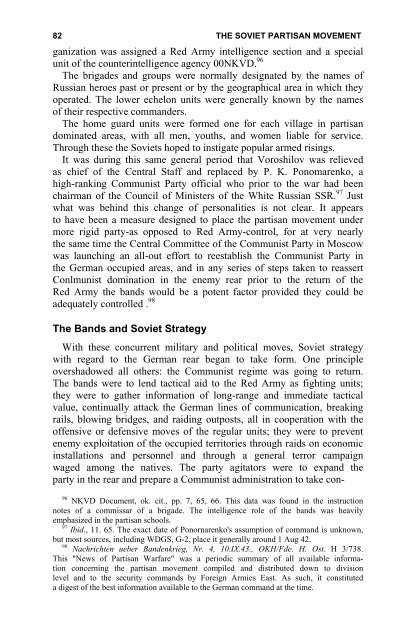the soviet partisan movement 1941-1944 by edgar m. howell
the soviet partisan movement 1941-1944 by edgar m. howell
the soviet partisan movement 1941-1944 by edgar m. howell
You also want an ePaper? Increase the reach of your titles
YUMPU automatically turns print PDFs into web optimized ePapers that Google loves.
82 THE SOVIET PARTISAN MOVEMENT<br />
ganization was assigned a Red Army intelligence section and a special<br />
unit of <strong>the</strong> counterintelligence agency 00NKVD. 96<br />
The brigades and groups were normally designated <strong>by</strong> <strong>the</strong> names of<br />
Russian heroes past or present or <strong>by</strong> <strong>the</strong> geographical area in which <strong>the</strong>y<br />
operated. The lower echelon units were generally known <strong>by</strong> <strong>the</strong> names<br />
of <strong>the</strong>ir respective commanders.<br />
The home guard units were formed one for each village in <strong>partisan</strong><br />
dominated areas, with all men, youths, and women liable for service.<br />
Through <strong>the</strong>se <strong>the</strong> Soviets hoped to instigate popular armed risings.<br />
It was during this same general period that Voroshilov was relieved<br />
as chief of <strong>the</strong> Central Staff and replaced <strong>by</strong> P. K. Ponomarenko, a<br />
high-ranking Communist Party official who prior to <strong>the</strong> war had been<br />
chairman of <strong>the</strong> Council of Ministers of <strong>the</strong> White Russian SSR. 97 Just<br />
what was behind this change of personalities is not clear. It appears<br />
to have been a measure designed to place <strong>the</strong> <strong>partisan</strong> <strong>movement</strong> under<br />
more rigid party-as opposed to Red Army-control, for at very nearly<br />
<strong>the</strong> same time <strong>the</strong> Central Committee of <strong>the</strong> Communist Party in Moscow<br />
was launching an all-out effort to reestablish <strong>the</strong> Communist Party in<br />
<strong>the</strong> German occupied areas, and in any series of steps taken to reassert<br />
Conlmunist domination in <strong>the</strong> enemy rear prior to <strong>the</strong> return of <strong>the</strong><br />
Red Army <strong>the</strong> bands would be a potent factor provided <strong>the</strong>y could be<br />
adequately controlled . 98<br />
The Bands and Soviet Strategy<br />
With <strong>the</strong>se concurrent military and political moves, Soviet strategy<br />
with regard to <strong>the</strong> German rear began to take form. One principle<br />
overshadowed all o<strong>the</strong>rs: <strong>the</strong> Communist regime was going to return.<br />
The bands were to lend tactical aid to <strong>the</strong> Red Army as fighting units;<br />
<strong>the</strong>y were to ga<strong>the</strong>r information of long-range and immediate tactical<br />
value, continually attack <strong>the</strong> German lines of communication, breaking<br />
rails, blowing bridges, and raiding outposts, all in cooperation with <strong>the</strong><br />
offensive or defensive moves of <strong>the</strong> regular units; <strong>the</strong>y were to prevent<br />
enemy exploitation of <strong>the</strong> occupied territories through raids on economic<br />
installations and personnel and through a general terror campaign<br />
waged among <strong>the</strong> natives. The party agitators were to expand <strong>the</strong><br />
party in <strong>the</strong> rear and prepare a Communist administration to take con-<br />
96 NKVD Document, ok. cit., pp. 7, 65, 66. This data was found in <strong>the</strong> instruction<br />
notes of a commissar of a brigade. The intelligence role of <strong>the</strong> bands was heavily<br />
emphasized in <strong>the</strong> <strong>partisan</strong> schools.<br />
97<br />
Ibid., 11. 65. The exact date of Ponornarenko's assumption of command is unknown,<br />
but most sources, including WDGS, G-2, place it generally around 1 Aug 42.<br />
98 Nachrichten ueber Bandenkrieg, Nr. 4, 10.IX.43., OKH/Fde. H. Ost. H 3/738.<br />
This "News of Partisan Warfare" was a periodic summary of all available information<br />
concerning <strong>the</strong> <strong>partisan</strong> <strong>movement</strong> compiled and distributed down to division<br />
level and to <strong>the</strong> security commands <strong>by</strong> Foreign Armies East. As such, it constituted<br />
a digest of <strong>the</strong> best information available to <strong>the</strong> German command at <strong>the</strong> time.
















